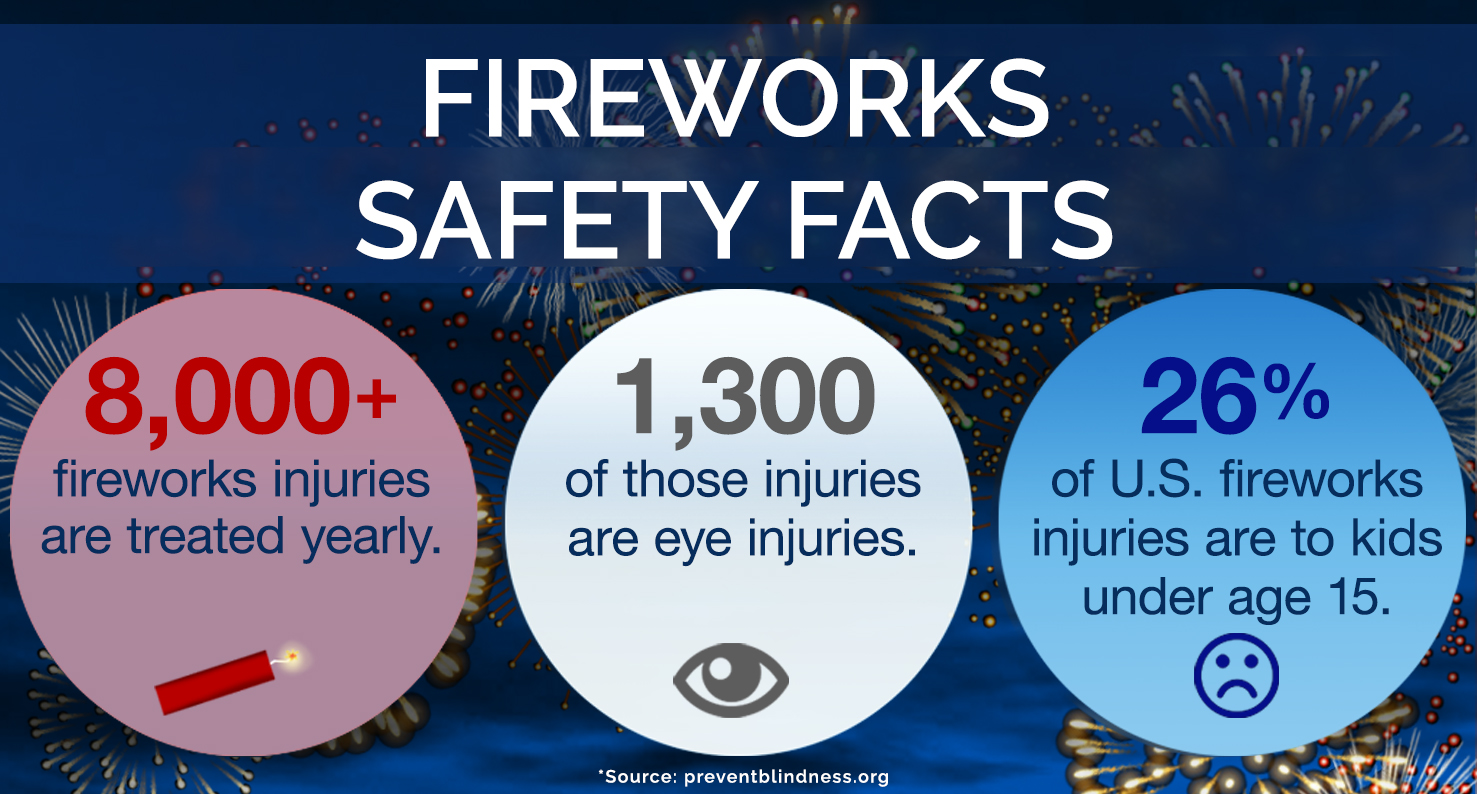One of our favorite times of the year in the United States surrounded by cookouts, pool parties, friends and family, the 4th of July is upon us. In addition to all the splendor, the month surrounding July 4th festivities also brings an increase of fireworks displays as well as an increase in firework-related injuries. Prevent Blindness America and the American Academy of Blindness sponsor June and July as Fireworks Eye Safety Months to raise awareness of the dangers, as well as, the safe protocols for viewing or handling pyrotechnic displays or devices. Most fireworks-related injuries occur during the month of July, and according to the most recent Consumer Product Safety Commission report, 14% of fireworks injuries have been eye injuries occurring mostly in children between the ages of 10 and 14. It is easy for any of us to get caught up in all the excitement and activity or become distracted by hosting responsibilities, conversations, and crowds. Take into consideration, as well, that these festivities and shows are generally conducted past dusk and simply navigating an event with numerous people and smoke can become challenging, let alone successfully dodging the sparkler-wielding children. Keep yourself, your children and your eyes safe this summer and enjoy holiday traditions with some important safety tips provided by the American Academy of Ophthalmology.
Fireworks Eye Safety Tips
For those who attend professional fireworks displays and/or live in communities surrounding the shows:
- Respect safety barriers at fireworks shows and view fireworks from at least 500 feet away.
- Do not touch unexploded fireworks; instead, immediately contact local fire or police departments to help.
For those who decide to purchase consumer fireworks because they live in states where they are legal, the Academy recommends the following safety tips to prevent eye injuries:
- Always have an adult supervise children, even sparklers! Sparklers burn up to 1800°F
- Ensure everyone is a safe distance of at least 500 feet when setting off fireworks.
- Never point or throw fireworks at another person
- Don’t shoot fireworks out of a glass or metal container. The explosion could shatter and expel glass or metal shards!
- Don’t hover. Never have any part of the body directly over a firework when lighting
- Firework didn’t ignite the first time? Soak it in water and discard it. Serious eye trauma and other injuries can occur when people mistake a firework for a “dud” or think that it’s no longer active or hot.
- Importantly, protect your eyes and wear safety glasses when setting off fireworks
The people injured by fireworks aren’t necessarily handling the explosives themselves. In fact, 65% of people injured by fireworks were bystanders, according to another study. This goes to show that children and people not handling fireworks themselves are in as much danger as the people actually lighting fireworks.

What to Do for a Fireworks Eye Injury
Fireworks-related eye injuries can combine blunt force trauma, heat burns, and chemical exposure. If an eye injury from fireworks occurs, it should be considered a medical emergency.
- Seek medical attention immediately.
- Do not rub your eyes.
- Do not rinse your eyes.
- Do not apply pressure.
- Do not remove any objects that are stuck in the eye.
- Do not apply ointments or take any blood-thinning pain medications such as aspirin or ibuprofen unless directed by a doctor.
If you or a loved one has sustained an eye injury related to a fireworks display, seek medical attention immediately. Depending on the extent of the injury, the emergency team may recommend that you consult with your local eye doctor for continued care.
Additionally, the summer season is an excellent time of year to schedule a comprehensive eye exam with your eye doctor. With a more flexible schedule and perhaps some time off, it’s probably easier to get you in to have your eyes thoroughly evaluated.
optomap offers a comprehensive view of the retina to gain essential information about ocular health. It is the only proven, clinically-validated, ultra-widefield retinal image capturing 82% or 200⁰ of the retina. optomap can help eye doctors in detecting potential issues before symptoms even begin to develop, which can improve patient outcomes in the long run by allowing for earlier treatment. Visit our website prior to scheduling your next eye exam to locate an optomap provider near you.